Mambo is one of the most successful Content Management Systems (CMS) in the world today. It is based on PHP, one of the best web scripting languages, and is used on a vast number of websites today. Best of all, it is free. The community, however, was shaken when a large number of core developers of Mambo split their ways with Miro, the company that backed Mambo. The "rebels" went on to fork their version of the project, Joomla!, which has been developed independently.
For the end user, this is not yet a real problem. The current versions of Mambo and Joomla! are compatible with each other, so the contents of this book are valid for Joomla! as well. Once both Mambo and Joomla! release new major versions (Mambo 5, Joomla! 2, for instance), the packages will probably go in different directions and will require PHP5. However until then, both are a good bet, even if the Joomla! project seems to be more active currently.
In this book, we assume that you have already installed Mambo (or Joomla!) and played around with it—even configured your first sites, taking help from a basic introduction either in online form (like the online documentation) or in printed form (like Building Websites with Mambo ISBN 1-904811-73-6 published by Packt Publishing). Now, we assume that you want to go one step further. We do not want to guide you through the installation of the software but would like to show you how to get the most out of it, either by using some of the excellent extensions the community provides to its users, or by optimizing your Mambo site with your own code. This book discusses some of the best Mambo extensions, including e-commerce/online shopping, document management, and web forums. You will see examples of how to create your own extensions for Mambo/Joomla!, along with a detailed description of the process, unlike some of the other sources. Finally, this book touches other important advanced aspects of running a CMS, including performance, security, and accessibility.
This chapter once again repeats the important terminology of Mambo/Joomla! and steps through the front end and administration sections. We assume that you have chosen to use the default content during installation; otherwise, your Mambo/Joomla! site may look different (but behave quite similarly).
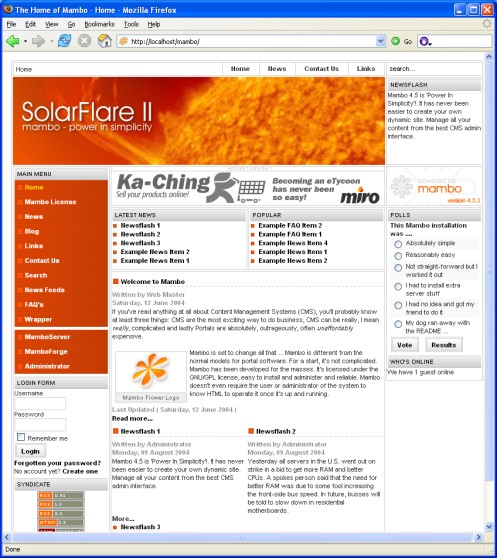 |
Figure 1.1: The Mambo user interface with the example data
This is how the Mambo user interface would look without the example data:
 |
Figure 1.2: Mambo user interface without any example data
Before you start working with the administration interface, you should first glance at the front end. While you are clicking around, we'll let you in on some of the concepts and basic principles behind the Mambo front end. That way it will be easier for you to maneuver through the administration interface.
You can already see from the sample page that a Mambo website consists of different
modules. These modules are responsible for, among other things, the search facility, the menus (MAIN
MENU), the polling (POLLS) or the RSS feed (SYNDICATE) of the page. Each module on the sample page is provided with its own grey bar that contains the module name as title. Under that is the content of the module.
A module in Mambo is basically a PHP script that gives a specific functionality to a specific area. One big advantage of having modules for standard tasks and functions is that a module can be displayed on as many pages as you want. Module administration is covered in detail in Chapter 3.
With Mambo, several modules are placed in a single position. Positions—for instance, top, left, right—are classical areas of a CMS. However, there are also positions without exact specifications such as user1, user2, and so on.
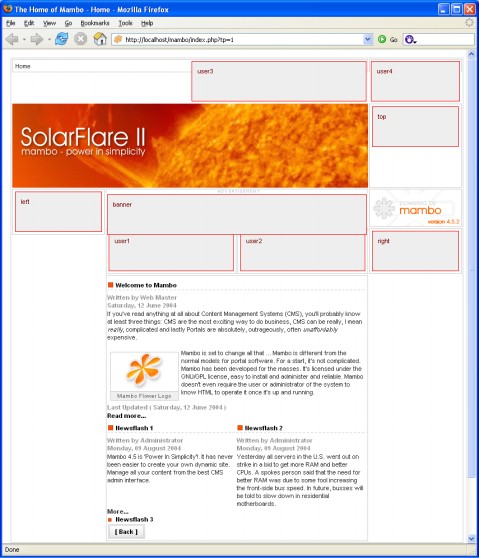 |
Figure 1.3: The various positions visualized
The location of the position is regulated by the template used for the site. The template performs two tasks:
It sets the location for the most important areas or positions.
It determines fundamental design rules such as the background color, character fonts, and so on. This generally done using a CSS file, which is part of the template.
The following screenshot shows the Mambo user interface using a template different from the standard template. You will learn how to create your own template in Chapter 2.
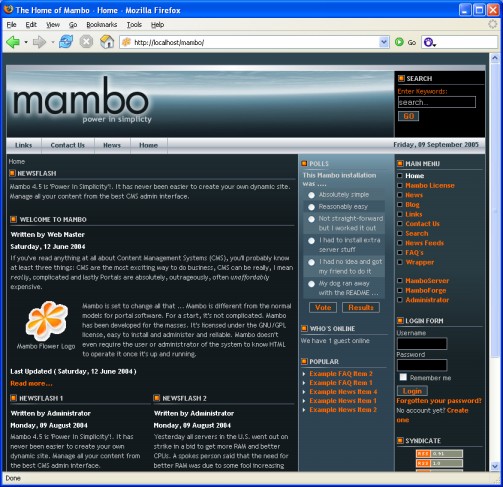 |
Figure 1.4: Mambo user interface using a different (non-standard) template
Beside these visible elements there are also invisible ones:
Mambots: Mambots perform important tasks such as calculating ratings, inserting pictures, and paginating the user interface. You will learn more about the Mambots that come along with Mambo in Chapter 3, and in Chapter 9 you will learn to create your own Mambots.
Components: Components are also invisible elements. A component is necessary for, say, the display of content. This component cannot be seen in the administration interface, but performs its work in the background. The administrator can easily control the components. Banners, polling, and RSS feeds are all examples of components that can be controlled by the administrator. In these cases, Modules and components interact.
The component is responsible for the functionality and the special settings in the administration interface; the modules are designed to handle the display duties in the front end. A trio can even emerge from this duet if yet another Mambot is involved. In the second half of this book you will meet these standard Mambo components again. Chapter 9 is dedicated to creating your own components.
Content: A content management system, naturally and above all, is about one thing—content. Content in Mambo is not a module, but its own group of objects, which is also defined in the templates. In Figure 1.3 you can see the content area in the center under the positions
user1anduser2. Once you are a bit familiar with the administration interface, you can change and customize content as discussed in Chapter 3.
By default, the
administration interface is in the administrator directory under the Mambo path. With a local installation this is, for example:
http://localhost/mambo/administrator/
With a web server installation, it often looks like this:
http://www.domain.tld/administrator/
If you call up that directory, the Mambo login mask appears (index.php). It displays the Mambo version and license and copyright.
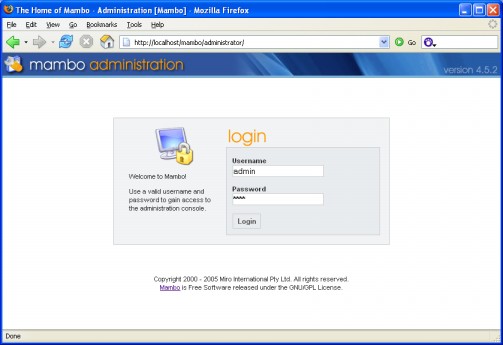 |
Figure 1.5: Logging in
When you start Mambo for the first time, you use the standard user admin with the password that was set at the installation. When you add additional users later, you can, of course, log in using a different user name.
Note
Administrator Path
The path to the administration interface can only be changed in a very, very cumbersome fashion. You could potentially rename the administrator directory, but you would have to search for the all of the references to that directory. Since the administrator directory is the only place in which that path is located in absolute form, this is not simple and therefore not recommended.
Mambo's administration interface has somewhat higher browser requirements than the Mambo front ends. To be precise, the front-end browser requirements depend on the HTML and CSS used in your template. So if you use a classical layout with tables, even the problem browser Netscape 4.x can do something with that.
The administration interface, on the other hand, has to track the user on the basis of sessions and accordingly, convey the information by means of a cookie. This means that cookies have to be enabled in the browser. It is equally necessary that JavaScript is activated. The JavaScript is checked for at login and, should it be missing, is mentioned by means of a message box.
Ancient or problematic browsers such as Netscape Navigator 4.x or the older versions of Internet Explorer are difficult to deal with. Newer browsers such as Internet Explorer 6, Mozilla's Firefox, and others such as Opera and Konqueror function well even with complex applications such as the HTML editor integrated in CMS.
Note
You should exercise caution when you are installing new modules, Mambots, and components. These can have installation requirements different from Mambo.
 |
Figure 1.6: Messed up Mambo—Netscape 4.x doesn't work with Mambo's back end
Once you are logged in, you will see a lot of icons. Mambo is equipped—and this is good news—with great icons. The whole interface is actually laid out very clearly.
 |
Figure 1.7: The start page of the administration interface
Let us first take a closer look at some of the most important areas of the interface.
The Workspace is made up of two sections on the index page: the quick view with the lists and the Control Panel. On other pages you will find all kinds of possible settings.
The quick view tab gives a status update about important information and is meant mainly for the system administrator:
Logged: This gives details about the currently logged in users. As super administrator, you can log out individual users, including yourself, by clicking on the red cross. If several users are logged in, the results may be spread over several pages. The MOS Pagination Mambot used for the pagination of the content is responsible for this internally. You have a choice as to how many results are displayed at the same time, and you can switch between the individual lists.Components: This lets you quickly change the components.Popular: This is a very interesting list and contains some of the most often accessed Mambo content elements. The creation date and the number of hits are displayed as additional information.LatestItems: This shows the most recent content elements with associated date and name of the creator.MenuStats: This lets you know how many entries are in which menu. Thus, if an element is not published, it does not appear in the statistics.
The control panel displays icons for the most important Mambo tasks. The tasks are organized in so-called managers—this is Mambo's special nomenclature. You can find all of the managers in the menu and, of course, in the course of this book.
Table 1.1: The elements in the control panel
|
Icon |
Title |
Description | |
|
|
|
Link to Mambo's online help. | |
|
|
|
Content manager. | |
|
|
|
Administers static content. This refers mostly to content like masthead, which isn't changed too often. | |
|
|
|
Administers all elements that are to be displayed on the homepage or start page. | |
|
|
|
Content in Mambo is organized as sections and sections, in turn, are organized as categories. The section manager administers sections. | |
|
|
|
The category manager administers the content categories. | |
|
|
|
The media manager makes it possible to upload pictures and documents in other formats like videos or PDFs to your site. The media files are located in the | |
|
|
|
Mambo comes with a convenient waste-paper basket, similar to current operating systems. When you delete a content element, a section, category, or other similar item, it is dumped into the waste-paper basket. You can remove these items from your system by deleting them there. | |
|
|
|
Mambo administers the four default menus that come with the system in the menu. You can modify menu entries here and set them to be visible or hidden. | |
|
|
|
In the User Manager, the administrator is concerned with users. For instance, the administrator can assign users to particular roles, such as editors. Mambo also uses the User Manager to control access to restricted areas of the site. | |
|
|
|
All the necessary settings for the website are present in Global Configuration. This includes everything including the basic messages, search engine optimization, and caching. |
The menu
contains all of the functions of the Mambo administration interface. Whenever we discuss a particular functionality in this book, we always include the menu path. Here is an example: If you want to see the result of a setting in preview, select the Site menu and from there, the Preview entry. As you can see, it has sub-entries. In order to open the website in a new window, click on In
New
Window. In short, the menu command reads Site
|
Preview
|
In
New
Window.
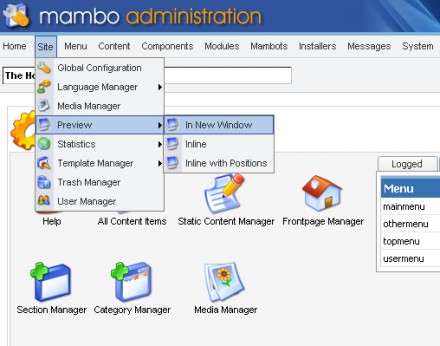 |
Figure 1.8: 'Site | Preview | In New Window' menu command
The menu is, however, faded out when you are editing a content entry, user, or other similar data. The reason is simple: When such an element is being edited, it is locked so that only one user at a time can make changes to it. If two users were to edit the same content at the same time, the edits of at least one of these users would be lost. If an element is locked, the user working on it should not just disappear into another Mambo menu area, since the element would stay checked-out. To make sure this does not happen, the menu bar is faded out.
Note
Unlock Everything
If you want to unlock locked elements, go to System
|
Global
Checkin. With it, all elements are checked in again. This command is very practical, but requires administrator rights.
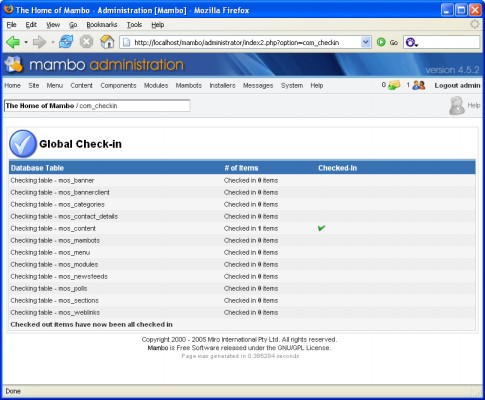 |
Figure 1.9: Unlock locked content elements
The path
(info bar) in the form field on the left above, under the menu, always shows where you are in Mambo. Mambo does not use categories for that like, say, Yahoo!, but displays the respective component that is responsible for the current page. For example, if you are in the editing content area, you will see com_content displayed there. If you were creating a new content element, the path shown would be com_content/new. The first entry is always the title of the website—in our case The
Home
of
Mambo—and it takes you back to the start page of the administration interface with a single mouse-click.
Note
Note that when you edit an element—content, menu entry, or user—that element is logged-out for all other Mambo administrators. However, the path remains visible. This means that you can go back to the start page of the administration interface at any time, even though the element is still logged-out.
The status
indication on the top right is specifically meant for the currently logged in user. The left icon (![]() ) shows whether the user has received any new messages; unread messages are displayed in red, read messages are no longer counted. Mambo has a simple internal communication network with which, for example, an administrator can inform an editor about any improvements. The (
) shows whether the user has received any new messages; unread messages are displayed in red, read messages are no longer counted. Mambo has a simple internal communication network with which, for example, an administrator can inform an editor about any improvements. The (![]() ) icon next to the messages icon shows the number of users who are actually logged in.
) icon next to the messages icon shows the number of users who are actually logged in.
The tool bar only displays a single element on the start page, the Help icon. There are a lot more elements on sub-pages, especially if you are editing elements such as content or users. Table 1.2 gives you an overview of these icons. By default, the icons are displayed in grey; if you roll your mouse cursor over them, they appear colored.
Table 1.2: Mambo Icons
When it comes to the icons in the tool bar, it is important to understand that Mambo has two work modes—a superordinate one for all managers in list format, and an editing mode for individual elements. The first enables you to create new elements, to copy them, and much more. In the Edit mode, a particular element is locked by Mambo and edited without the menu bar being visible. The work in the manager in list format is described in the Editing
Lists section, the Edit mode in the Editing
Elements section.
Many of the icons from the tool bar require that one or more elements are selected, else a JavaScript-generated error message appears. Selection of the elements arranged in list format is done with the control boxes on the left of the elements. If you click on the control box next to the table heading title, all elements are selected. A second click unselects all of the control boxes.
If you are already in Edit mode, you don't have to select anything else in order to work on an individual element. All commands are immediately applied to this element.
In principle,
there are only two kinds of pages in the Mambo administration interface: List-oriented ones, which administer several elements at one time, and pages that administer individual elements. Even the Media Manager is a list, only that it has a different way of displaying it. The biggest difference consists of the fact that pages for individual Mambo elements are logged-out or locked.
This section, however, deals with the editing of lists. Here you will learn the fundamental functions and receive some tips. Editing content is a good example since it covers all the important functions. Some of the other lists contain fewer functions. This list can be found under Content
|
All
Content
Items or directly from the index page by means of the All
Content
Items icon on the Control
Panel.
 |
Figure 1.10: The list with the content elements
The tool bar changes from list to list, depending upon functionality of the manager. Table 1.2 gives you an overview of the various icons; these icons will help you to familiarize yourself with Mambo very quickly.
As in the case of content elements, you can sort the results with some lists too. A number of default options are available for the sorting. The possible values for these options are available in a menu. One of these, for example, is the News value in the Select
Section option that displays all the content saved in the News section. Another option is a free text filter; with it, you can specify a portion of the title of an element. In order for the filter to work, you have to exit the text field or press the Enter key (Mambo implements this with JavaScript and the onBlur event handler). If you want to cancel the free text filter later on, delete the text field and exit.
 |
Figure 1.11: Filtered content
As your website grows, the amount of content, as well as the number of users will naturally continue to increase and the lists will grow accordingly. For that reason, Mambo uses pagination for lists, meaning that the results will get distributed over several pages, starting from a set threshold. The MOS
Pagination
Mambot is responsible for that internally.
You can decide in a menu below the table as to how many elements you want displayed on a page. The standard setting for the length of a list is ten; you can change that to anywhere from five to fifty. On the right, next to the list of choices, you can see the number of elements (Results) and the number of elements that are currently displayed. With the links above the list of choices for the length of the list, you can maneuver back and forth between the individual pages.
Global List Length
You can set the standard list length in the Global
Configuration (Site
|
Global
Configuration) page. You will set the appropriate list length setting on the List
Length: field in the Site tab.
Depending on the type of list, you will sometimes find a legend for the icons used in the list below the list length. With some managers, there are also hints displayed on the right above the list.
Now to the actual table: Depending on the type of list, it can look completely different. Mind you, with all these differences, there are also a lot of similarities—the first column shows the position of the respective element in the list, then there is a column where you can select the element or elements that you want to work on. If only one element can be selected, as is the case with the Menu
Manager, radio buttons are displayed instead of checkboxes. The title or name of the element comes next. It is clickable and if you click on it, the element opens in Edit mode.
Icons in the table are generally also clickable. They either switch a function on and off (for example, whether the content is to be published or not) or refer to additional settings (say, for the menu elements). You can change the position of the element in the list with the arrow icon (Reorder). This is especially useful in case of elements for which the sequence of display is important. If you roll the mouse cursor over an icon, you get Quickinfo. Mambo executes this either with the title or alt attribute of a picture or by means of JavaScript and <
div> layer. The <
div> layer is used if more than a few words of information are required.
 |
Figure 1.12: Left: Quickinfo per graphic file; Right: Quickinfo per JavaScript
There are many
different ways to get to the Edit mode:
Click on the title of an element in the list of the manager.
Click on the title of an element in quick view, for example, in the
LoggedorPopularlists.Select an element and click
Editin the toolbar.Create a new element with the
Newicon in the toolbar.Use a command or an icon that puts you automatically in
Editmode (for example,Site|GlobalConfiguration)
 |
Figure 1.13: Editing a content item
You can recognize Edit mode by the fact that the menu bar disappears. As already mentioned above, you should then avoid any navigation within the administration interface, be it by means of the path or by using browser navigation (Back button), or the appropriate content element will stay locked. In order to unlock the locked element, you have to either go back to the element and use the save or cancel command or invoke the System | Global Checkin command. You can only use the latter if you have the appropriate rights.
Depending on the type of element, the page can look completely different in Edit mode. For content elements, two online editors and a tab appear as you can see in Figure 1.13.
Users, on the other hand, can be administered in a much simpler form as you can see in Figure 1.14.
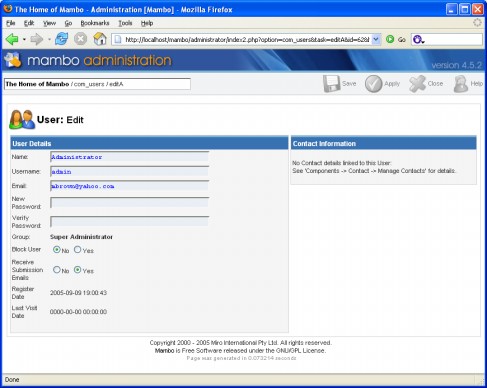 |
Figure 1.14: Fewer settings required for user administration
While working with Mambo day in and day out, one quickly gets used to certain work habits. A practical one is to always have one browser window open with the administration interface and one with the front end. This is a quick way to see the changes you have made.
Mambo offers two types of previews for these purposes:
The preview in
Editmode displays a content element or something similar in a new window. It is suitable for a fast check, does not, however, reveal the complete page.A preview of the complete page is executed with the
Site|Previewmenu command.
Take a closer look at the three menu commands for the preview of complete pages. Selecting the New
Window option calls up the homepage of the website in a new window. In practice, it is faster if you have already opened the front end in a browser window, because changes that you have made in Edit mode can be examined immediately.
The second, Inline, option opens the page in a window section. You can navigate normally and if you want to exit the administration interface, you simply click the Open
in
new
window link on the top right of the page. The effect is then just like with In
New
Window.
 |
Figure 1.15: The preview can optionally be opened in a new window
The third, Inline
with
Positions, option shows the positions on the Mambo page as boxes with frameworks and titles. Thus you can see very clearly how a template is built.
Since navigation is tucked into one of these positions, this preview cannot be navigated. If you click on a link in the content area, the display of the positions disappears.
 |
Figure 1.16: Preview with positions
Position-Preview for Every Page
Mambo
creates the practical preview of the positions by attaching the tp=1 parameter to the URL. That means that you can also use this preview for sites other than your own Mambo site. How would you, for instance, like to see the positions in the template of the official Mambo site http://www.mamboserver.com/? Simply call up http://www.mamboserver.com/index.php?tp=1. If you don't want to betray this information for your own site, open the frontpage.php file in the includes directory. Search for the following lines and comment them out (with /* at the beginning of the line and with */ at the end):
$tp = mosGetParam( $_GET, 'tp', 0 );
if ($tp) {
echo '<div style="height:50px;background-color:#eee;margin:2px;
padding:10px;border:1px solid #f00;color:#700;">';
echo $position;
echo '</div>';
return;
}
Once you have finished the work in the administration area, you can log yourself out with the Logout link on the top right (logout.php). If you simply close the browser, you are still logged in. Mambo terminates the session after a certain time interval. You can specify the length of this time interval in the Login
Session
Lifetime under the Server tab in Site
|
Global
Configuration. Mambo uses its own data and not PHP's session management utility or the session run time from the php.ini configuration file to do this.
Note
Note that you will be logged out automatically at the end of the session time if you do nothing and don't navigate anywhere within Mambo. This also happens if the page with the administration interface remains open. It could be really annoying if you have made extensive changes to the open page without saving or navigating within Mambo and your session expires. If this happens, you are automatically shuffled to the Login page and your data is lost. By logging in again, you end up on the index page again.
It now becomes apparent that Mambo is no Windows program, but a web application. The technological foundation for this principle is the HTTP (Hyper Text Transfer Protocol) web protocol. An HTTP connection consists of a request from the 'Client' (the browser) to the web server and the response of the server. Every click on a link or the transmission of a form is a request. The web server only understands that the client is being worked on when it receives a request. The server only stores values when the page or the HTML form is transferred to the server or when a new page is requested.
This chapter has given you a quick run through Mambo's function mode and has given you an introduction to the important terms and terminologies of the system. But enough of basics! In the next few chapters you will learn what you can do with Mambo and how you can customize it to your own needs.



















